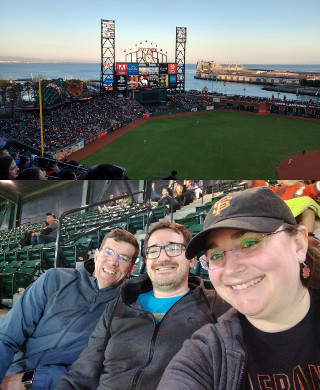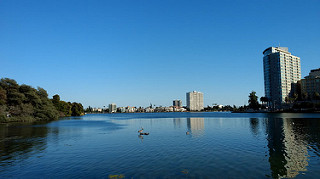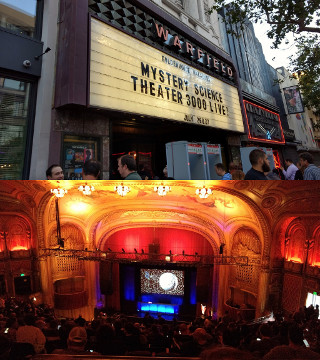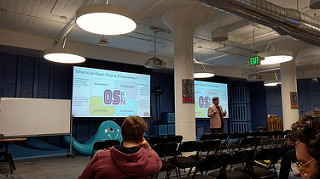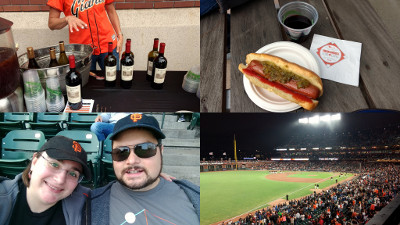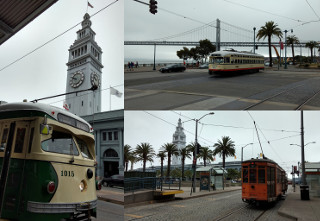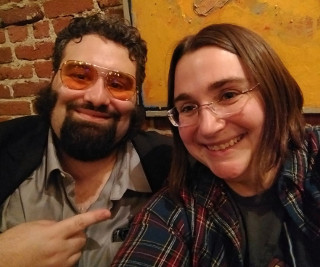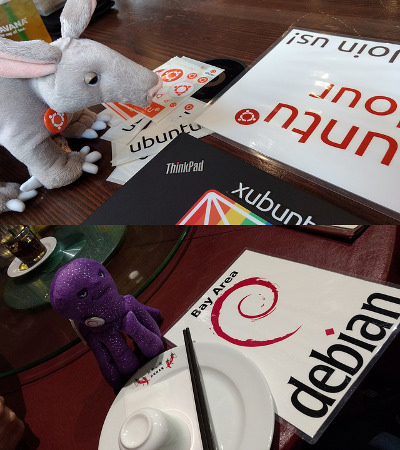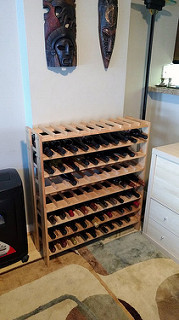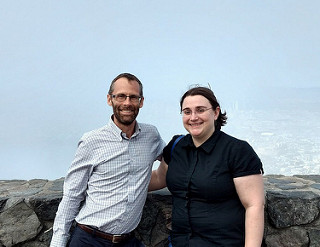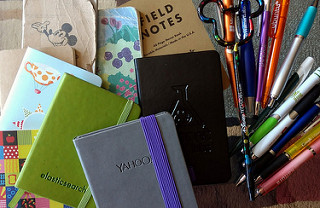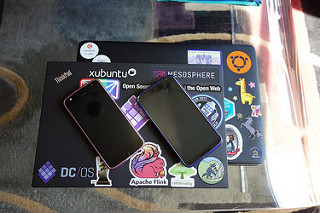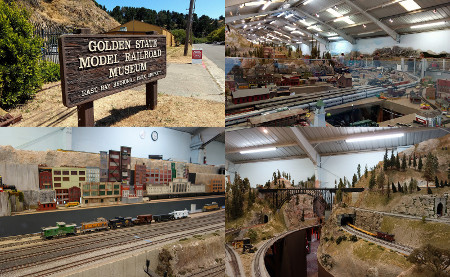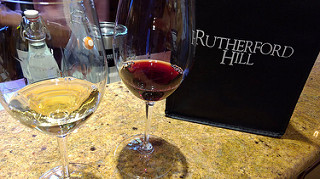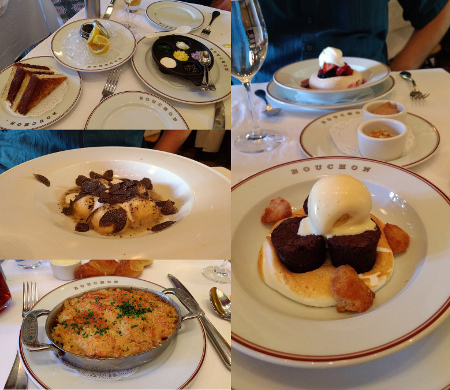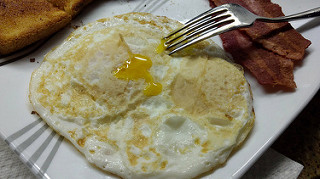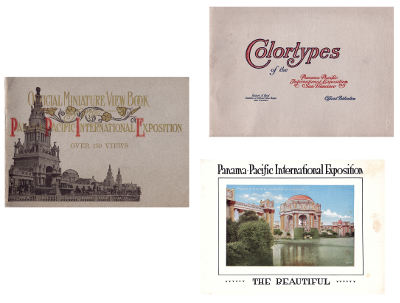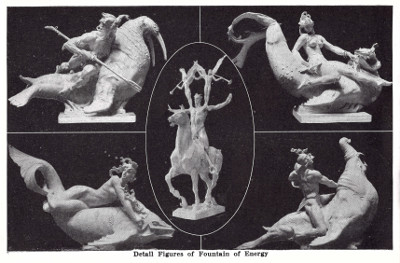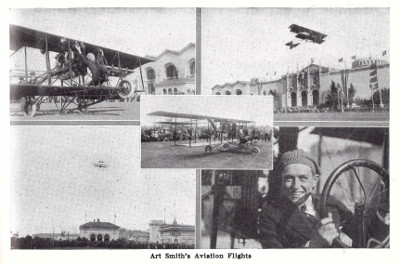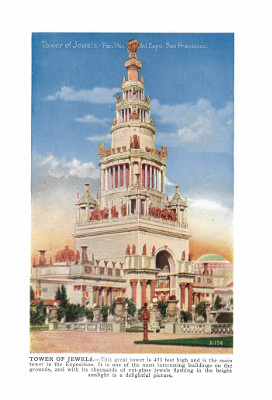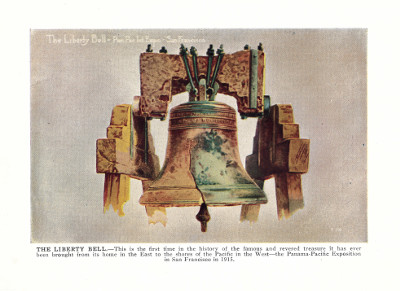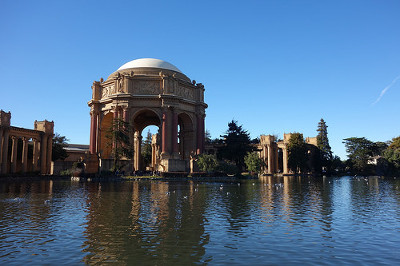As June wound down and July rushed in, both MJ and I happened to friends in town the same week leading into the 4th of July weekend. Pile in extra time at work for both of us and we’ve been busy.
At work I have started to be the community team representative for the Bay Area Apache Mesos User Group meetups. Marketing has long handled logistics of these events, so my role has been more along the lines of welcoming attendees and playing MC so that the speakers feel welcome and the event runs smoothly.
On June 28th my first opportunity to speak at one of these events came up as I had to quickly fill in for a colleague who couldn’t make it into town for it. The event was on Microservices and SMACK Stack on Azure (strictly speaking, SMACK is: Apache Spark, Apache Mesos, Akka, Apache Cassandra and Apache Kafka, but like the LAMP stack you can swap out like components). Continuing a partnership that also included some internal collaboration that week, we partnered with several folks from Microsoft for this public event.
Prior to the meetup I worked with Patrick Brennan, who was our on-site Mesosphere liaison working with the team at Microsoft, to discuss preparations for the demo at the meetup. Since he was all set up with Azure already and my own time was limited, he tossed up a cluster I could use for the demos and then we made sure we had all the access controls in place to run the demo. I then collaborated with speakers Rob Bagby and Julien Stroheker who work on the Azure team over at Microsoft to put together an agenda where I’d lay the foundation for their talks by introducing DC/OS and doing a quick demo of the SMACK stack running on Azure. I’m quite happy to say that even with limited time to prepare, and my own lack of experience with Azure, everything came together. The ability to run DC/OS anywhere you want is something that makes me so proud to work on it so I can share the power of that flexibility with others.
Following my 20 minute primer and demo, Rob gave us a live tour of the Azure UI to demonstrate the mechanisms for using DC/OS on it. He including tips from the Learn DC/OS on ACS collection of documentation that he maintains, which I had only recently learned about and is incredibly valuable if you’re looking to run DC/OS with the Azure Container Service (ACS). His talk was followed by one from Julien, who is one of many folks working in the DC/OS community to come up with open source tooling to get DC/OS to do their bidding on specific platforms (cloud, on premises). In his case, he’s built a proof of concept DC/OS autoscaler for clouds, right now supporting Azure. The PoC code can be found on GitHub: julienstroheker/dcos-autoscaler.
 Julien Stroheker sharing autoscaling
Julien Stroheker sharing autoscalingOne of the most rewarding things about my job right now is seeing community-based efforts like this being created and shared. Just last week we held an office hours where we spoke to Flach Jauffrey and Benjamin Vouillaume who have written boot2dcos, which they’re using to turn employee desktops that are unused at night into DC/OS agents to process workloads. When employees leave for the evening, the machines are shut down, PXE booted to load up a Linux image and DC/OS and get to work. Very cool stuff.
But, as much as I enjoy it, enough about work! I took my first formal vacation day since I started in January the day after the meetup to spend the day with David, who was in San Francisco for a few days. His visit was one stop of several during a trip around the country by train that took just over two weeks. I admit that I’m a bit jealous of the ambition of his train trip. My own single cross country train adventure in May was just three and a half days, and went one direction. He did an entire clockwise loop that took him down south, through Texas and the southwest, up through California and then on to the Empire Builder, a route that goes further north than the California Zephyr that I took. Jealousy around his time on trains aside, I was very happy that he included a stop in San Francisco during his journey.
The day we spent together began in Union Square where we got him a transit card so we could get around the city all day. We also got an obligatory photo together next to the Powell Street cable cars. He had been to San Francisco many times, so we forewent the cable car ride and focused on spending the day at places he hadn’t seen yet. First on our list was Japantown! I love sushi and promised I’d give him a tour of my favorites so I could try to convince him to enjoy sushi. Alas, I’m quite sure I failed. He ate it, but even with my expertly crafted varietal mix of sweet, spicy, fishy and less so, it seems my dear friend is just not into sushi. I did enjoy trying though. While we were there we also stopped by Chocolate Chair, which is one of the many liquid nitrogen-driven ice cream shops that have been popping up. Their most recent claim to fame is Dragon’s Breath (SFGATE article here), which are colorful, flavored cereal puff balls that are infused with liquid nitrogen so that when you eat them fog very amusingly comes out your nose and mouth. Dragon! David bravely partook, I helped myself to a few, but mostly enjoyed my own very delicious bowl of strawberry ice cream.
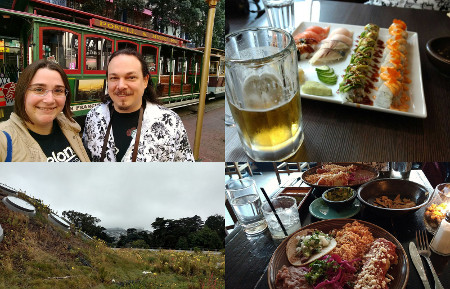
The rest of the afternoon was spent over at the California Academy of Sciences. It’s one of my favorite science museums, and with it right there in Golden Gate Park and proximity to the MUNI Metro line, it’s a convenient and delightfully San Francisco place to visit to get a bunch of experiences at once. We hit the highlights of the museum: the living roof, the huge rain forest domed environment, the planetarium, the penguins, a bit of the aquarium. They also have a great Pterosaurs: Flight in the Age of Dinosaurs exhibit right now that I really enjoyed. When the museum closed at 5 a quick walk took us to the metro line that took us back downtown, where our adventures concluded with a lovely Mexican dinner at Tropisueño, and cupcakes over at the Metreon. Well-fed and a bit tired, his next train awaited him across the bay, so I saw him off on a ferry that would take him to the train station where he’d catch the Coast Starlight north. A sad farewell for me, for sure, but he had another week of train adventures ahead.
More photos from our touristing day in San Francisco here: https://www.flickr.com/photos/pleia2/sets/72157685698889625
As I mentioned, MJ had a friend in town that week too, a childhood friend who comes in a couple times a year and stays with us. When in town she works from an office out here, and then her and MJ do dinners and weekends together. I met up with them for a couple meals (including an evening at Kabul Afghan Cuisine down in Sunnyvale, must go back!), but mostly kept myself busy on my own. MJ and I did get to enjoy a dinner alone together on Friday, going over to my favorite local restaurant, Anchor & Hope, which we hadn’t been to together in some time. The food is great, the beer list is one of my favorites in the city, it’s just a block from home and in general it’s a comfortable place because we’re so familiar with it. A perfect place for a dinner together to reconnect and relax.
On Saturday, July 1st I wandered up to Berkeley to do what ends up being a quarterly trip to pick up the latest pile of comic books for the series I’m reading. As I may have written before, I’ve always enjoyed graphic novels and had an interest in comic books, but cost prevented any serious following as a youth, and it was only since Marvel came out with the Princess Leia series a couple years ago, and several other Star Wars titles, that I really started getting into them as an adult. Today I’m following the Wonder Woman reboot (rebirth), a selection of the Star Wars titles, and then I pick up a few here and there as they come up (a Lost in Space series last year, American Gods this year). A friend of mine also clued me into the six DC/Looney Tunes crossover comics that turned out to be really great. I was able to find a few of them while up there shopping too, and then went to eBay to grab the remaining ones. I drifted from the comic book store in downtown Berkeley over to the one closer to Rockridge, picked up a couple more books, and then I was hungry! That’s how I ended up with my solo lunch at Zachary’s Chicago Pizza in Oakland. It was delicious, and if you’re going to have a lunch by yourself, you might as well make it a giant plate of dough, cheese and tomatoes.

The next day Caligula got his second Golden Gate Park visit! It was fun for the four of us to get out. Plus, with how excited my normally lazy cat gets as soon as he goes to the park, it was nice to have three of us there to take turns walking him around where ever he wanted to go.
Soon, all friends had departed and our city was our own again. I promised MJ some quiet time during the long 4th of July weekend, so we decided not to make plans for the holiday. But we did make plans to go up to Richmond to visit the Golden State Model Railroad Museum. On our way up to Richmond we stopped at our favorite BBQ place, so we were happy and full by the time we saw the trains.
I had just recently learned about the museum from a friend at a Linux meetup and it’s run by the East Bay Model Engineers Society (EBMES). The members of the society maintain all the track layouts and then open the museum to the public on Sundays when they have trains running. It seems like a really interesting way of being a model train hobbiest, the building that houses it is big and I’m sure very few people have the space to make very much in their own homes, especially here in California where basements are rare and houses themselves tend to be smaller than elsewhere in the country.
It was a lot of fun talking to one of the members there. We told him of our recent Amtrak journey and geeked out a bit over the best passenger routes around California, even day trips that can be pretty interesting. He was right in my head when he mentioned you could take Amtrak up to Sacramento for the day and go to the train museum there (I still haven’t been!).
Getting to see all the trains running and people fiddling them got me an even more firm understanding of the scales. I had been considering N scale because I won’t have a lot of space (planning on putting my layout in my office, once I have one), but once I saw people working on them up close I think I’m going to go with HO scale. It’s the most popular (though N has been catching up), and it’s big enough to show nice details and not feel like I’m going to break a tiny delicate thing. It’s also small enough that I think I can enjoy a cute layout without taking up massive amounts of space. It was also interesting to learn how separate-worlds the different scale groups are, these people get super specialized in their scales and don’t really answer questions about the other scales. There also seems to be a friendly rivalry between them all. I also met a little girl who was super excited about all the geek stuff I was wearing, which was super sweet, and I hope convinced her that adults can sport train engine earrings and wear Star Wars t-shirts forever.
The visit was inspiring too. I’m somewhat tempted to buy a couple kits to start playing with things before I have space for it, just because I’m excited. Resisting for now though, I shall have space soon enough (within the year, I hope!) and I have enough other projects for other hobbies to keep me busy in the meantime.
A lot more photos from the museum here: https://www.flickr.com/photos/pleia2/sets/72157683695335350/
While we were up in Richmond we also saw signs for the Rosie the Riveter/WWII Home Front NHP museum. I had no idea it existed, it’s a little warehouse building not too far from the model railway museum. The museum starts with the focus on Rosie the Riveter and the changing roles of women as WWII progressed, but also touched upon general life at home in the US during and just after the war, the internment camps for Japanese-Americans and more. The displays were bright and interesting, and well organized. Unfortunately we got there pretty late in the afternoon so we had to skim through the exhibits pretty quickly. I’d like to go back at some point to view it properly, there’s also a short movie that goes along with the exhibits that plays regularly throughout the day and they do events there, so it might be worth looking at a calendar for when we can make time to go up again.
More photos from our visit to this museum here: https://www.flickr.com/photos/pleia2/sets/72157682967715334
I mentioned in my last general update post that I’d started doing a bit more work with Partimus lately. Last Friday MJ departed on a week and a half long business trip and so on Saturday I made plans to meet up with our executive director at one of the low-income housing facilities in the tenderloin, just beyond Union Square. For the first hour I worked on debugging an issue with guest sessions failing to log in. It was an issue we’d seen across all the locations that we service and ended up being impossible to diagnose remotely with the tools we had. Sitting there digging through logs and doing tests finally led me to figure out what was going on, the details of which I shared here. Essentially the command to remove the temporary guest users was failing due to a stuck lock file so the system was adding a guest user every time someone logged in until it couldn’t make any more (it hit UID 999). I wrote a script to remove the lock file and delete stray users that any of our volunteers can run if this happens again, but I’ll bake a more permanent solution into a custom Lubuntu ISO I hope to help build soon.
However, the main goal of this visit was to take a look at the PXE boot server that one of our volunteers built. It’s been tested and works for installing 32-bit Lubuntu, but we want 64-bit and in general need to do an audit and document what this server does so we can improve it, and replicate it on other sites as needed. This introduced me to the basement of the building, where lots of spiders live. I get along with spiders, but there was also no internet access or cell signal down there, so I brought along my handy portable hard drive (one of my best investments ever!) and cloned the drive so I could work on it at home. I won’t get to it this weekend, but I hope to carve out some time next Sunday to start digging into it.

I’ve been staying incredibly busy with work this week and would love to write about that now too, but that will have wait until another blog post. It’s 10PM and need to get to bed soon. I need be on the road by 7:45AM tomorrow morning to get down to Santa Clara for the Cloud+Data Next conference. I’ll be giving a Day 2 Operations talk in the early afternoon. It’s a talk that I was uncertain about before I gave it the first time, but it’s really grown on me, and I’m really proud of the improvements I’ve been putting into it. Wish me luck tomorrow!


